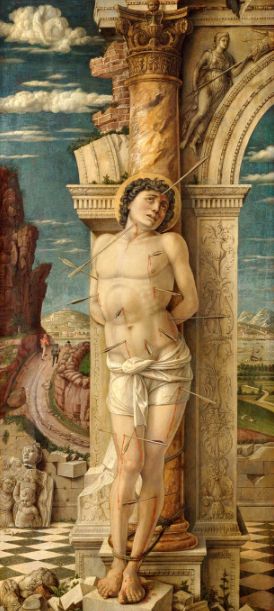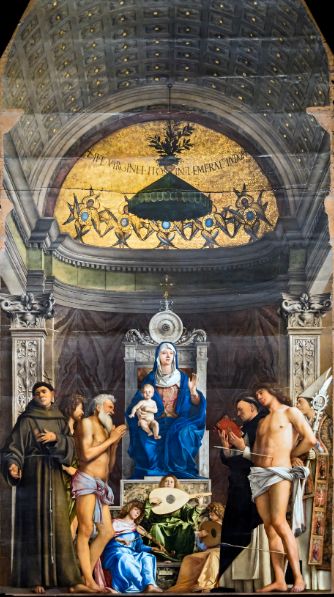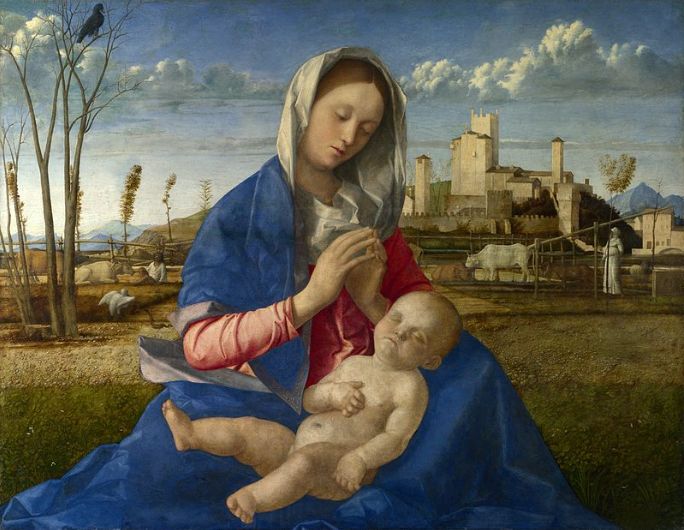In the 15th century European art history, Venice stood out for its unique geographical location and cultural background, forming a distinct artistic style. This style blended classical and Byzantine elements, reflecting the confluence of various cultures. Venetian artists reinterpreted and innovated ancient heritage, creating unforgettable works. Among them, Andrea Mantegna and Giovanni Bellini were particularly notable.

Andrea Mantegna's painting "St. Sebastian", created in 1460, fully exemplifies the characteristics of early Italian Renaissance art. This painting showcases a clear space through precise perspective, with naturalistic landscapes in the background, ancient architectural and decorative motifs, and an idealized human figure. The depiction of St. Sebastian, a member of Emperor Diocletian's imperial guard who was sentenced to death by arrows for converting to Christianity, is reborn through the artist's brushstrokes, becoming a revered saint.
Mantegna received rigorous artistic training in Padua, a hub for humanists and artists of the time. His teacher, Francesco Squarcione, was an avid collector of ancient sculptures, deeply influenced by Greek and Roman art. This influence permeated Mantegna's works, which are rich in classical elements, reflecting his deep understanding and application of sculpture in painting.
Giovanni Bellini, closely related to Mantegna through family ties, also played a significant role in Venetian art. Bellini's father, Jacopo Bellini, was an important figure in early Venetian Renaissance. His drawings of classical relics, preserved in the Louvre and the British Museum, demonstrate a profound grasp of archaeological knowledge. Giovanni Bellini, inheriting his father's legacy, absorbed Mantegna's classical style and further innovated and developed it.

Bellini created numerous religious-themed works in Venice, with the "St. Job Altarpiece" being the most famous. This painting showcases the unique Venetian style: a confined space framed by semicircular walls, soft light, and rich colors. Bellini's delicate brushwork and skillful use of color bring the figures to life, making the saints more relatable and satisfying the contemporary demand for accessible religious art.
The works of Mantegna and Bellini not only exhibit technical innovation but also reflect the cultural characteristics of Venice. As a commercial and cultural hub, Venice's artistic style was a fusion of various cultural elements. In Bellini's "St. Job Altarpiece", architectural styles include Brunelleschi-like domes and distinctive Venetian Byzantine mosaic decorations, embodying Venice's unique position as a crossroads of Eastern and Western cultures.
Mantegna's works display a stronger classical influence. Through his study and emulation of ancient sculptures, he developed a rigorous and powerful artistic style. Vasari praised Mantegna for always believing that ancient sculptures were more perfect and beautiful than anything in nature, a pursuit of classical beauty evident in "St. Sebastian."

Giovanni Bellini, on the other hand, developed a softer and more poetic style on the foundation of classicism. His later works, such as "Madonna of the Meadow", depict natural landscapes with meticulous detail and express the inner emotions of the figures, creating serene and harmonious scenes. Bellini combined Florentine perspective techniques with Venetian color usage, forming a distinctive Venetian painting style.
Overall, the artistic achievements of Mantegna and Bellini lie not only in their individual innovations and creations but also in their significant contributions to the development of the Venetian composite style. By rediscovering and reinterpreting classical art, they infused new vitality into Venetian art, establishing its crucial position on the 15th-century European art stage. This composite style reflects Venice's uniqueness as a cultural crossroads and showcases the creativity and adaptability of artists in the face of diverse cultural influences.